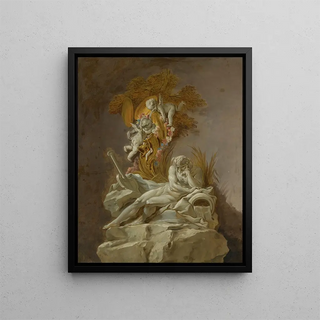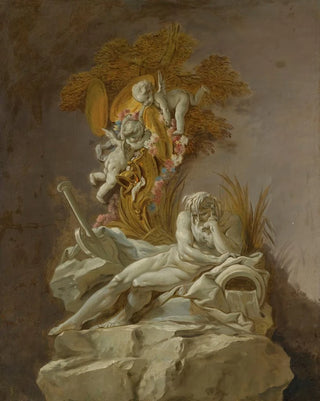Art print | Fontaine Study I - François Boucher


View from behind

Frame (optional)
"Reproduction" Art print of Fontaine Study I - François Boucher – Captivating Introduction
The artwork "Fontaine Study I" by François Boucher presents itself as an open window into the 18th century, a time when art and life intertwined in delicate harmony. This study, which evokes the refinement and lightness characteristic of the Rococo style, invites the viewer to immerse themselves in a universe where beauty and elegance reign supreme. It is a frozen moment, a sketch that, although preliminary, already captures the splendor of the compositions that the artist will develop further. Through this art print, one discovers not only a work but also an atmosphere, a creative breath that transcends time.
Style and uniqueness of the work
The aesthetic of "Fontaine Study I" is characterized by exceptional finesse and meticulous attention to detail. Boucher, master of chiaroscuro, skillfully plays with light and shadow to bring his characters and environment to life. The fountain, a central element of this composition, is surrounded by floral motifs and graceful figures that seem to dance around it, creating a lively dynamic. The pastel colors, soft and shimmering, evoke an almost ethereal lightness, while the curved and sinuous lines reinforce the sensation of movement. This painting is not just a depiction of a scene but an invitation to feel the joy and carefree spirit of a suspended moment, where nature and art come together to celebrate beauty.
The artist and his influence
François Boucher, born in 1703, is one of the most emblematic artists of French Rococo. His work, marked by a keen sense of decoration and palpable sensuality, profoundly influenced the art of his time and subsequent generations. As a court painter, he captured the spirit of his era, juggling between mythology and scenes of daily life. Boucher was also a fervent advocate of decorative arts, integrating his talents into the design of tapestries, porcelains, and interior décors. His ability to fuse painting with other art forms paved the way for a new approach to artistic creation, where

Matte finish

View from behind

Frame (optional)
"Reproduction" Art print of Fontaine Study I - François Boucher – Captivating Introduction
The artwork "Fontaine Study I" by François Boucher presents itself as an open window into the 18th century, a time when art and life intertwined in delicate harmony. This study, which evokes the refinement and lightness characteristic of the Rococo style, invites the viewer to immerse themselves in a universe where beauty and elegance reign supreme. It is a frozen moment, a sketch that, although preliminary, already captures the splendor of the compositions that the artist will develop further. Through this art print, one discovers not only a work but also an atmosphere, a creative breath that transcends time.
Style and uniqueness of the work
The aesthetic of "Fontaine Study I" is characterized by exceptional finesse and meticulous attention to detail. Boucher, master of chiaroscuro, skillfully plays with light and shadow to bring his characters and environment to life. The fountain, a central element of this composition, is surrounded by floral motifs and graceful figures that seem to dance around it, creating a lively dynamic. The pastel colors, soft and shimmering, evoke an almost ethereal lightness, while the curved and sinuous lines reinforce the sensation of movement. This painting is not just a depiction of a scene but an invitation to feel the joy and carefree spirit of a suspended moment, where nature and art come together to celebrate beauty.
The artist and his influence
François Boucher, born in 1703, is one of the most emblematic artists of French Rococo. His work, marked by a keen sense of decoration and palpable sensuality, profoundly influenced the art of his time and subsequent generations. As a court painter, he captured the spirit of his era, juggling between mythology and scenes of daily life. Boucher was also a fervent advocate of decorative arts, integrating his talents into the design of tapestries, porcelains, and interior décors. His ability to fuse painting with other art forms paved the way for a new approach to artistic creation, where






